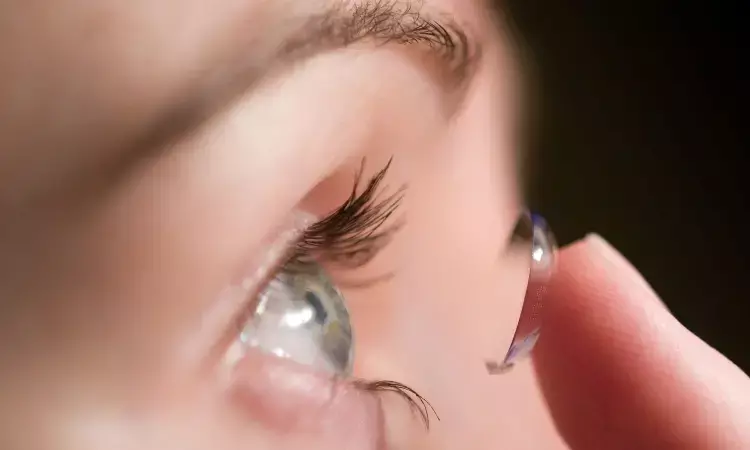- Home
- Medical news & Guidelines
- Anesthesiology
- Cardiology and CTVS
- Critical Care
- Dentistry
- Dermatology
- Diabetes and Endocrinology
- ENT
- Gastroenterology
- Medicine
- Nephrology
- Neurology
- Obstretics-Gynaecology
- Oncology
- Ophthalmology
- Orthopaedics
- Pediatrics-Neonatology
- Psychiatry
- Pulmonology
- Radiology
- Surgery
- Urology
- Laboratory Medicine
- Diet
- Nursing
- Paramedical
- Physiotherapy
- Health news
- Fact Check
- Bone Health Fact Check
- Brain Health Fact Check
- Cancer Related Fact Check
- Child Care Fact Check
- Dental and oral health fact check
- Diabetes and metabolic health fact check
- Diet and Nutrition Fact Check
- Eye and ENT Care Fact Check
- Fitness fact check
- Gut health fact check
- Heart health fact check
- Kidney health fact check
- Medical education fact check
- Men's health fact check
- Respiratory fact check
- Skin and hair care fact check
- Vaccine and Immunization fact check
- Women's health fact check
- AYUSH
- State News
- Andaman and Nicobar Islands
- Andhra Pradesh
- Arunachal Pradesh
- Assam
- Bihar
- Chandigarh
- Chattisgarh
- Dadra and Nagar Haveli
- Daman and Diu
- Delhi
- Goa
- Gujarat
- Haryana
- Himachal Pradesh
- Jammu & Kashmir
- Jharkhand
- Karnataka
- Kerala
- Ladakh
- Lakshadweep
- Madhya Pradesh
- Maharashtra
- Manipur
- Meghalaya
- Mizoram
- Nagaland
- Odisha
- Puducherry
- Punjab
- Rajasthan
- Sikkim
- Tamil Nadu
- Telangana
- Tripura
- Uttar Pradesh
- Uttrakhand
- West Bengal
- Medical Education
- Industry
Orthokeratology lense use does not impact tear film stability and condition of meibomian glands

A new study by Jing Ruan and team shows that wearing orthokeratology lenses overnight did not substantially influence the stability of the tear film or the condition of the meibomian glands, showing that using orthokeratology lenses continuously for a whole year had little impact on the ocular surface. The findings of this study were published in BMC Ophthalmology.
To slow the growth of myopia, orthokeratology lenses that are worn at night are advised. By temporarily modifying the corneal surface using a reverse geometry design, they can affect the ocular surface while lying on the cornea. Therefore, this study examined how children aged 8 to 15 years responded to wearing orthokeratology lenses overnight in terms of tear film stability and meibomian gland health.
33 children with monocular myopia were included in this self-controlled, prospective trial. They were given orthokeratology lenses for at least a year. 33 myopic eyes made up the ortho-k group, which was the experimental group. The same participants' emmetropic eyes made up the control group. Using a Keratograph 5M (Oculus, Wetzlar, Germany), tear film stability and meibomian gland status were assessed. To compare the data between the two groups, Wilcoxon signed-rank tests and paired t tests were applied.
The key findings of this study were:
1. The experimental and control groups' non-invasive first tear film break-up times (NIBUTf) at the one-year visit were 6.15 ± 2.56 s and 6.18 ± 2.61 s, respectively.
2. In these groups, the lower tear meniscus height was 18.74 0.05 mm and 18.65 0.04 mm, respectively.
3. By applying Wilcoxon signed-rank tests, it was determined that there was no difference between the experimental and control groups in terms of meibomian gland loss or the non-invasive average tear film break-up time.
Throughout the course of the 12-month research, children who wore ortho-k lenses saw no appreciable changes in the quantity or quality of their meibomian glands. The ocular surface was little affected by wearing ortho-k lenses overnight, while the axial development of the eye was controlled. Because overnight ortho-k lens use has no impact on the health of the ocular surface and meibomian gland, it may be regarded as safe. The findings of this study should be strengthened by other long-term prospective investigations.
Reference:
Ruan, J., Zhang, Y., & Chen, Y. (2023). Influence of overnight orthokeratology on tear film and meibomian glands in myopic children: a prospective study. In BMC Ophthalmology (Vol. 23, Issue 1). Springer Science and Business Media LLC. https://doi.org/10.1186/s12886-023-02883-8
Neuroscience Masters graduate
Jacinthlyn Sylvia, a Neuroscience Master's graduate from Chennai has worked extensively in deciphering the neurobiology of cognition and motor control in aging. She also has spread-out exposure to Neurosurgery from her Bachelor’s. She is currently involved in active Neuro-Oncology research. She is an upcoming neuroscientist with a fiery passion for writing. Her news cover at Medical Dialogues feature recent discoveries and updates from the healthcare and biomedical research fields. She can be reached at editorial@medicaldialogues.in
Dr Kamal Kant Kohli-MBBS, DTCD- a chest specialist with more than 30 years of practice and a flair for writing clinical articles, Dr Kamal Kant Kohli joined Medical Dialogues as a Chief Editor of Medical News. Besides writing articles, as an editor, he proofreads and verifies all the medical content published on Medical Dialogues including those coming from journals, studies,medical conferences,guidelines etc. Email: drkohli@medicaldialogues.in. Contact no. 011-43720751


